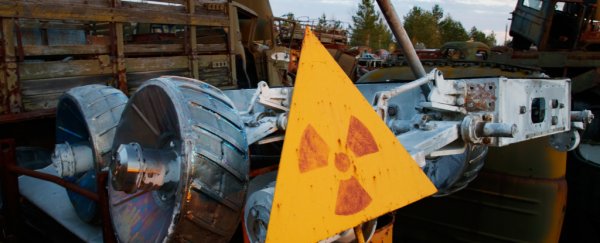At the site of the Chernobyl nuclear disaster in Ukraine, work is almost finished on a huge new solar plant that's set to provide one megawatt of renewable power for the local electricity grid.
The new plant sits just a hundred metres (328 feet) from the Object Shelter, nicknamed the "sarcophagus", a sealed metal dome designed to prevent further radiation leakage from the remains of the Chernobyl Nuclear Power Plant.
The blast that occurred on 26 April 1986 remains one of two most disastrous nuclear accidents in history alongside Fukushima, but the installation of these solar panels offers hope that the site can now be used to help rather than harm the planet.
"This solar power plant can cover the needs of a medium-sized village," Yevgen Varyagin, boss of the Solar Chernobyl running the project, told AFP. That's the equivalent of about 2,000 homes, and eventually the region as a whole could produce 100 times that.
The soil in the area remains heavily contaminated, and Ukrainian authorities have said it would take more than 24,000 years before people could safely return to live there, but the new plant shows that this vast area of sealed-off land can be put to good use.
And it's partly possible thanks to the Shelter Object – installed in late 2016 to replace the ageing concrete shield originally put in place, it reduced the radiation near the plant to one-tenth of its previous level.
The new solar plant covers some 16,000 square metres (3.95 acres) and is fitted with 3,800 photovoltaic panels to convert sunlight into electricity.
That's not to say there aren't still a lot of problems with the site. As one precaution, the solar panels are fixed to concrete slabs rather than being put in the ground - drilling and digging is still strictly prohibited.
But there are now some 25 square kilometres (6,178 acres) that have been made available by the Ukrainian government for solar power developments, with 60 proposals currently being considered by the authorities.
Solar Chernobyl and several partners also recently completed a 4.2-megawatt solar power plant in nearby Belarus, which still falls in the irradiated zone. Another advantage of the site is that it's already connected up to the grid because of the nuclear power station, which continued to operate in some form until the year 2000.
The original blast in 1986 happened when Chernobyl was part of the USSR, and was caused by a reactor failure. It led to the largest ever uncontrolled radioactive release into the atmosphere, and within three months had directly claimed 31 lives. The area that was eventually contaminated covered millions of people.
After a lengthy evacuations and clean up process, the region is gradually becoming useful again more than 30 years later. Let's hope the modern-day Chernobyl can soon become known for solar power rather than nuclear disaster.
"Bit by bit we want to optimise the Chernobyl zone," Varyagin told Anna Hirtenstein at Bloomberg last year. "It shouldn't be a black hole in the middle of Ukraine."
